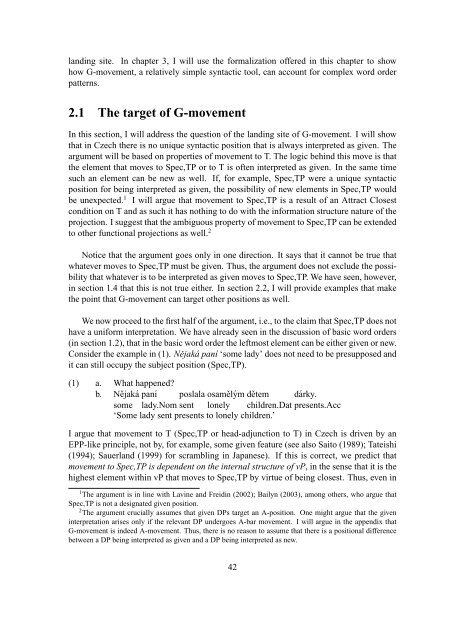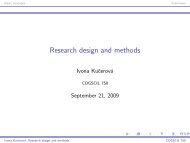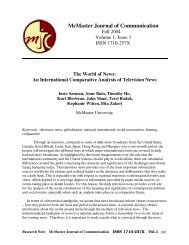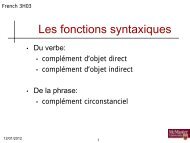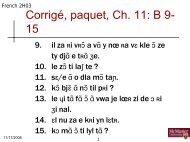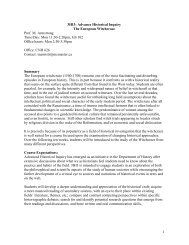The Syntax of Givenness Ivona Kucerová
The Syntax of Givenness Ivona Kucerová
The Syntax of Givenness Ivona Kucerová
Create successful ePaper yourself
Turn your PDF publications into a flip-book with our unique Google optimized e-Paper software.
landing site. In chapter 3, I will use the formalization <strong>of</strong>fered in this chapter to show<br />
how G-movement, a relatively simple syntactic tool, can account for complex word order<br />
patterns.<br />
2.1 <strong>The</strong> target <strong>of</strong> G-movement<br />
In this section, I will address the question <strong>of</strong> the landing site <strong>of</strong> G-movement. I will show<br />
that in Czech there is no unique syntactic position that is always interpreted as given. <strong>The</strong><br />
argument will be based on properties <strong>of</strong> movement to T. <strong>The</strong> logic behind this move is that<br />
the element that moves to Spec,TP or to T is <strong>of</strong>ten interpreted as given. In the same time<br />
such an element can be new as well. If, for example, Spec,TP were a unique syntactic<br />
position for being interpreted as given, the possibility <strong>of</strong> new elements in Spec,TP would<br />
be unexpected. 1 I will argue that movement to Spec,TP is a result <strong>of</strong> an Attract Closest<br />
condition on T and as such it has nothing to do with the information structure nature <strong>of</strong> the<br />
projection. I suggest that the ambiguous property <strong>of</strong> movement to Spec,TP can be extended<br />
to other functional projections as well. 2<br />
Notice that the argument goes only in one direction. It says that it cannot be true that<br />
whatever moves to Spec,TP must be given. Thus, the argument does not exclude the possibility<br />
that whatever is to be interpreted as given moves to Spec,TP. We have seen, however,<br />
in section 1.4 that this is not true either. In section 2.2, I will provide examples that make<br />
the point that G-movement can target other positions as well.<br />
We now proceed to the first half <strong>of</strong> the argument, i.e., to the claim that Spec,TP does not<br />
have a uniform interpretation. We have already seen in the discussion <strong>of</strong> basic word orders<br />
(in section 1.2), that in the basic word order the leftmost element can be either given or new.<br />
Consider the example in (1). Nějaká paní ‘some lady’ does not need to be presupposed and<br />
it can still occupy the subject position (Spec,TP).<br />
(1) a. What happened?<br />
b. Nějaká paní poslala osamělým dětem dárky.<br />
some lady.Nom sent lonely children.Dat presents.Acc<br />
‘Some lady sent presents to lonely children.’<br />
I argue that movement to T (Spec,TP or head-adjunction to T) in Czech is driven by an<br />
EPP-like principle, not by, for example, some given feature (see also Saito (1989); Tateishi<br />
(1994); Sauerland (1999) for scrambling in Japanese). If this is correct, we predict that<br />
movement to Spec,TP is dependent on the internal structure <strong>of</strong> vP, in the sense that it is the<br />
highest element within vP that moves to Spec,TP by virtue <strong>of</strong> being closest. Thus, even in<br />
1 <strong>The</strong> argument is in line with Lavine and Freidin (2002); Bailyn (2003), among others, who argue that<br />
Spec,TP is not a designated given position.<br />
2 <strong>The</strong> argument crucially assumes that given DPs target an A-position. One might argue that the given<br />
interpretation arises only if the relevant DP undergoes A-bar movement. I will argue in the appendix that<br />
G-movement is indeed A-movement. Thus, there is no reason to assume that there is a positional difference<br />
between a DP being interpreted as given and a DP being interpreted as new.<br />
42


